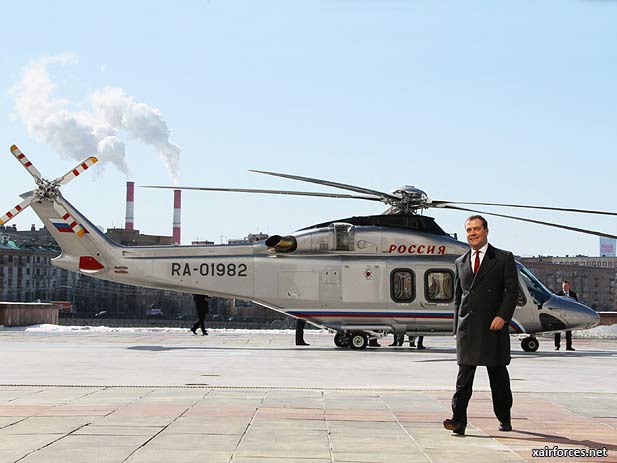
World leaders to land on helipads in the Kremlin

The all-weather 4162-square metre Helicopter Pad 1 built on the grounds of the Moscow Kremlin near the wall bordering Tainitsky Garden can handle helicopters of various classes.
Moscow will soon sprout helicopter landing pads. A ban is still in force on helicopter flights over Moscow but the city’s transport development programme for up to 2016 envisages increased use of air transport, which is impossible without lifting the ban.
Helipads will be built on the rooftops of buildings housing government ministries, with due account for the need to preserve historical buildings. The measure is aimed at providing the country’s leaders with greater mobility and the opportunity to travel by air. A helipad for the head of state at the Kremlin is ready and the Presidential Administrative Department expects it will also be used for visiting foreign leaders.
Flights over the city were banned back in Soviet times. The restriction, imposed “to protect vital state facilities for national security purposes”, is still in force. An exception is made for the Ministry for Emergencies, the ambulance service, police and top national leaders. To date, the entire area within the Moscow Ring Highway is a restricted zone.
Since May 2 this year, however, commercial flights have been allowed over the city at an altitude of at least 8100 metres.
The decision to use Moscow air space was prompted by traffic congestion in the capital. Some traffic jams are caused by the leaders’ motorcades, for which roads are blocked for long periods. It was therefore decided to remove the officials’ limousines from the streets.
The all-weather 4162-square metre Helicopter Pad 1 built on the grounds of the Moscow Kremlin near the wall bordering Tainitsky Garden can handle helicopters of various classes. There is no parking space for a standby helicopter in the Kremlin.
To vacate space for the pad, makeshift summer structures built about 20 years ago for the Federal Protection Service, and which housed stables, were pulled down and a bank built up. The control centre is located in Petrovskaya Tower. Helicopters will come in to land either from the direction of Zamoskvoretsky Bridge or from the side of Zaradye (the area formerly occupied by the Rossiya Hotel). The pad has room for two helicopters.
The Presidential Administrative Department assures that helicopter flights will do no harm to the Kremlin walls and the Kremlin. Nevertheless, to be on the safe side, meters to monitor possible impact on the walls have been installed in the towers. The helipad is on state-protected territory but the Culture Ministry has given the go-ahead to the construction, said Viktor Khrekov, press secretary of the Presidential Administrative Department. Earlier, UNESCO had expressed concern about construction work in the Kremlin, which is on its world cultural heritage list. The press secretary said that, if international organisations had any questions, they should discuss them with the relevant government ministry.
Head of the Presidential Administrative Department Vladimir Kozhin said that the flight from the government Vnukovo airport to the Kremlin would take 5–7 minutes, not counting take-off and landing. The leaders of other countries visiting Russia will reach the centre of Moscow in the same way. The Department notes that foreign heads of state visiting the Russian President at his Sochi residence often use Russian helicopters.
“This option is under consideration but it all depends on protocol and the other countries’ rules”, Vlasdimir Kozhin explains. For example, the Chinese leader is not permitted to use helicopters during his foreign trips for security reasons.
Security experts think that moving by air rather than over land would be safer for foreign guests and Russian leaders. “The helicopters of our leaders have the latest radio-electronic, infra-red and optical equipment to neutralise any missile fired at the helicopter. In general, it is much more difficult to smuggle into Moscow and use shoulder-fired missiles than, for example, a grenade thrower, which could theoretically be used to hit the leaders’ motorcades”, military expert Ilya Kramnik believes.
The head of the Presidential Administrative Department said that the project would cost 200 million roubles.
The Russian Government’s building also got a helipad this year. Prime Minister Dmitry Medvedev uses a light Italian-made Agusta AW-139 helicopter. Vladimir Putin will fly to the Kremlin on board Mi-8 heavy helicopters.
The Ministry for Emergencies has a helipad on Vatutina Street and a pad will soon be built on the roof the Defence Ministry on Znamenka Street. Floating helipads developed by the Helicopter Industry Association may soon appear. Under that project, seven movable landing stages are to be set up for air taxis and rescue helicopters. The first floating parking is to be built on the Khimki Reservoir this year.
Business centres, such as Crocus City and Victory Plaza, have been building their own helipads. Moscow City, a business area, will have two helipads.
The Moscow City transport development programme for up to 2016 envisages development of air transport in the capital and building, jointly with the Transport Ministry, of a network of helipads: ten within the city limits and 40 outside Moscow.
Source: Russia & India Report - Marina Obrazkova, RIR News - 15 July 2013
Photo: The Russian Prime Minister Dmitry Medvedev walks from a helicopter as he arrives at a pad in front of the Russian Government headquarters in Moscow on March 27, 2013. (Photo by AP)
(15.07.2013)
|